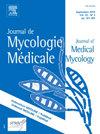Invasive pulmonary aspergillosis in patients with lung cancer: Risk Factors for in-hospital mortality and Predictors of Clinical Outcomes
IF 1.8
4区 医学
Q3 MYCOLOGY
引用次数: 0
Abstract
Background
Invasive pulmonary aspergillosis (IPA) is a common complication in patients with hematological malignancies, and has also been reported in some solid tumors, but IPA in lung cancer patients has not been well described in recent years. This study aims to identify the risk factors for in-hospital mortality, and factors influencing antifungal efficacy in lung cancer patients with IPA.
Methods
We retrospectively collected data from all inpatients with positive aspergillus cultures or positive polymerase chain reaction(PCR) for aspergillus DeoxyriboNucleic Acid (DNA) in respiratory samples in the Third People's Hospital of Chengdu from January 2016 to December 2023. A total of 101 lung cancer patients with IPA were identified. Patients were divided into survival (n = 77) and non-survival (n = 24) groups. We analyzed their clinical characteristics, laboratory examination, risk factors for in-hospital mortality, and responses to antifungal treatment.
Results
Among 101 lung cancer patients diagnosed with IPA, The most common isolated species was Aspergillus section fumigati (61.39 %). Aspergillus culture were positive in 65 cases (64.36 %), and positive PCR were 41 cases (40.59 %). 86 patients (85.15 %) received treatment containing voriconazole or isavuconazole. The in-hospital mortality rate was 23.76 % (n = 24). Independent risk factors for in-hospital mortality included low albumin level (odds ratio [OR] 0.80, 95 % confidence interval[CI], -0.279–1.881, P = 0.0025), respiratory failure (OR 12.7, 95 % CI, 10.2–15.2,P = 0.0055), and febrile neutropenia (FN) (OR 7.33,95 % CI,5.21–9.45,P = 0.0079). In multivariate analysis of antifungal treatment response, respiratory failure was associated with lower odds of a successful response (OR 13.3, 95 %CI, 9.64–16.92, P = 0.0447), whereas treatment containing voriconazole or isavuconazole was associated with higher odds (OR 7.51, 95 % CI, 5.22–9.79, P = 0.0147).
Conclusion
Risk factors for in-hospital mortality in lung cancer patients with IPA included hypoalbuminia, FN, and respiratory failure. In antifungal treatment response, respiratory failure was associated with a lower adds of successful response, whereas treatment containing voriconazole or isavuconazole was associated with a higher odds.
肺癌患者的侵袭性肺曲霉病:院内死亡的危险因素和临床结果的预测因素
背景:侵袭性肺曲霉病(invasive pulmonary aspergillosis, IPA)是血液学恶性肿瘤患者的常见并发症,在一些实体肿瘤中也有报道,但近年来肺癌患者的IPA尚未得到很好的报道。本研究旨在探讨肺癌IPA患者住院死亡的危险因素及影响抗真菌效果的因素。方法回顾性收集成都市第三人民医院2016年1月至2023年12月住院患者呼吸样本中所有曲霉培养阳性或聚合酶链反应(PCR)检测曲霉脱氧核糖核酸(DNA)阳性的数据。共发现101例肺癌IPA患者。患者分为生存组(n = 77)和非生存组(n = 24)。我们分析了他们的临床特征、实验室检查、住院死亡率的危险因素以及对抗真菌治疗的反应。结果101例确诊为IPA的肺癌患者中,最常见的分离种为烟曲霉(61.39%)。曲霉培养阳性65例(64.36%),PCR阳性41例(40.59%)。86例(85.15%)采用伏立康唑或异唑康唑治疗。住院死亡率为23.76% (n = 24)。院内死亡的独立危险因素包括低白蛋白水平(比值比[OR] 0.80, 95%可信区间[CI], - 0.79% - 1.881, P = 0.0025)、呼吸衰竭(比值比12.7,95% CI, 10.2-15.2,P = 0.0055)和发热性中性粒细胞减少症(比值比7.33,95% CI, 5.21-9.45,P = 0.0079)。在抗真菌治疗反应的多变量分析中,呼吸衰竭与较低的成功反应几率相关(OR 13.3, 95% CI, 9.64-16.92, P = 0.0447),而含有伏立康唑或异戊康唑的治疗与较高的成功反应几率相关(OR 7.51, 95% CI, 5.22-9.79, P = 0.0147)。结论肺癌IPA患者住院死亡的危险因素包括低白蛋白血症、FN和呼吸衰竭。在抗真菌治疗反应中,呼吸衰竭与较低的成功反应相关,而含有伏立康唑或异戊康唑的治疗与较高的成功反应相关。
本文章由计算机程序翻译,如有差异,请以英文原文为准。
求助全文
约1分钟内获得全文
求助全文
来源期刊
CiteScore
5.10
自引率
2.80%
发文量
68
审稿时长
6-12 weeks
期刊介绍:
The Journal de Mycologie Medicale / Journal of Medical Mycology (JMM) publishes in English works dealing with human and animal mycology. The subjects treated are focused in particular on clinical, diagnostic, epidemiological, immunological, medical, pathological, preventive or therapeutic aspects of mycoses. Also covered are basic aspects linked primarily with morphology (electronic and photonic microscopy), physiology, biochemistry, cellular and molecular biology, immunochemistry, genetics, taxonomy or phylogeny of pathogenic or opportunistic fungi and actinomycetes in humans or animals. Studies of natural products showing inhibitory activity against pathogenic fungi cannot be considered without chemical characterization and identification of the compounds responsible for the inhibitory activity.
JMM publishes (guest) editorials, original articles, reviews (and minireviews), case reports, technical notes, letters to the editor and information. Only clinical cases with real originality (new species, new clinical present action, new geographical localization, etc.), and fully documented (identification methods, results, etc.), will be considered.
Under no circumstances does the journal guarantee publication before the editorial board makes its final decision.
The journal is indexed in the main international databases and is accessible worldwide through the ScienceDirect and ClinicalKey platforms.

 求助内容:
求助内容: 应助结果提醒方式:
应助结果提醒方式:


